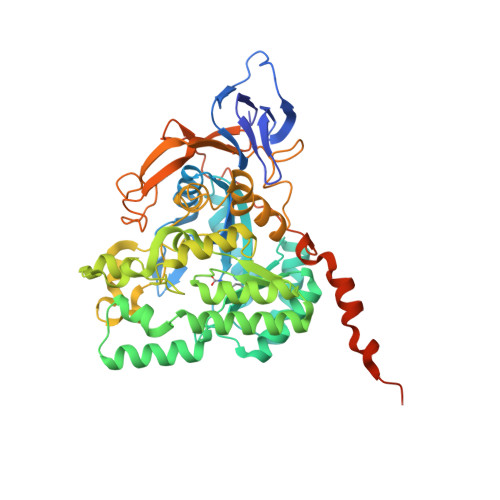The Crystal Structures of Dihydropyrimidinases Reaffirm the Close Relationship between Cyclic Amidohydrolases and Explain Their Substrate Specificity.
Lohkamp, B., Andersen, B., Piskur, J., Dobritzsch, D.(2006) J Biol Chem 281: 13762-13776
- PubMed: 16517602
- DOI: https://doi.org/10.1074/jbc.M513266200
- Primary Citation of Related Structures:
2FTW, 2FTY, 2FVK, 2FVM - PubMed Abstract:
In eukaryotes, dihydropyrimidinase catalyzes the second step of the reductive pyrimidine degradation, the reversible hydrolytic ring opening of dihydropyrimidines. Here we describe the three-dimensional structures of dihydropyrimidinase from two eukaryotes, the yeast Saccharomyces kluyveri and the slime mold Dictyostelium discoideum, determined and refined to 2.4 and 2.05 angstroms, respectively. Both enzymes have a (beta/alpha)8-barrel structural core embedding the catalytic di-zinc center, which is accompanied by a smaller beta-sandwich domain. Despite loop-forming insertions in the sequence of the yeast enzyme, the overall structures and architectures of the active sites of the dihydropyrimidinases are strikingly similar to each other, as well as to those of hydantoinases, dihydroorotases, and other members of the amidohydrolase superfamily of enzymes. However, formation of the physiologically relevant tetramer shows subtle but nonetheless significant differences. The extension of one of the sheets of the beta-sandwich domain across a subunit-subunit interface in yeast dihydropyrimidinase underlines its closer evolutionary relationship to hydantoinases, whereas the slime mold enzyme shows higher similarity to the noncatalytic collapsin-response mediator proteins involved in neuron development. Catalysis is expected to follow a dihydroorotase-like mechanism but in the opposite direction and with a different substrate. Complexes with dihydrouracil and N-carbamyl-beta-alanine obtained for the yeast dihydropyrimidinase reveal the mode of substrate and product binding and allow conclusions about what determines substrate specificity, stereoselectivity, and the reaction direction among cyclic amidohydrolases.
Organizational Affiliation:
Department of Medical Biochemistry and Biophysics, Karolinska Institutet, SE-17177 Stockholm, Sweden.

















